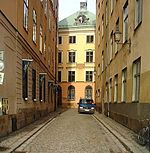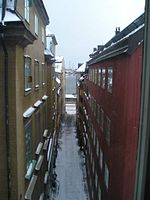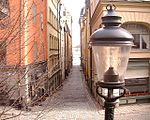Skeppsbron
Streets in StockholmWharves

Skeppsbron (Swedish: "The Ship's Bridge") is both a street and a quay in Gamla stan, the old town of Stockholm, capital of Sweden, stretching from the bridge Strömbron in front of the Royal Palace southward to Slussen. The quay Skeppsbrokajen runs along the street. Several alleys connects Skeppsbron to the thoroughfare Österlånggatan: Slottskajen, Lejonbacken, Slottsbacken, Telegrafgränd, Skeppar Karls Gränd, Bredgränd, Kråkgränd, Nygränd, Brunnsgränd, Skottgränd, Stora Hoparegränd, Drakens Gränd, Ferkens gränd, Gaffelgränd, Johannesgränd, Packhusgränd, Tullgränd, Norra Bankogränd, Södra Bankogränd, Norra Dryckesgränd, Södra Dryckesgränd, Slussplan
Excerpt from the Wikipedia article Skeppsbron (License: CC BY-SA 3.0, Authors, Images).Skeppsbron
Skeppsbron, Stockholm Gamla stan (Södermalms stadsdelsområde)
Geographical coordinates (GPS) Address External links Nearby Places Show on map
Geographical coordinates (GPS)
| Latitude | Longitude |
|---|---|
| N 59.323611111111 ° | E 18.075277777778 ° |
Address
Skeppsbron
Skeppsbron
111 30 Stockholm, Gamla stan (Södermalms stadsdelsområde)
Sweden
Open on Google Maps











